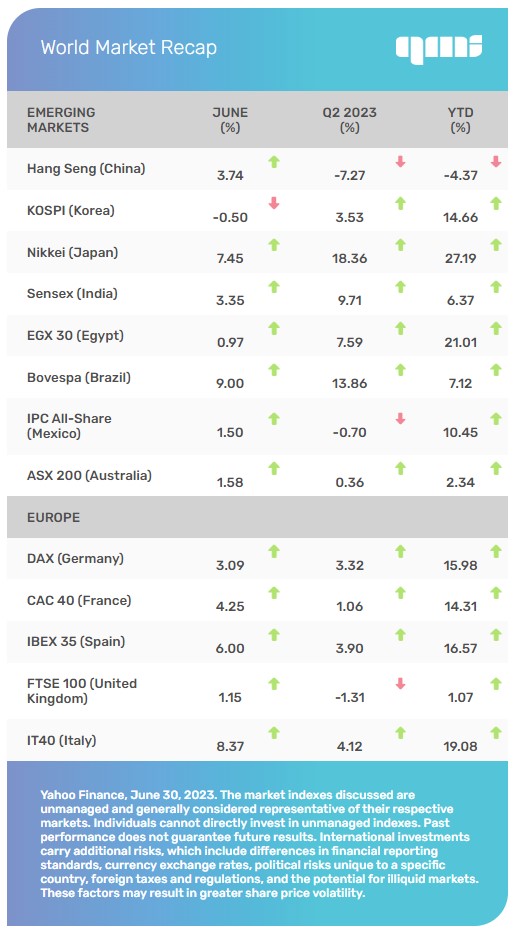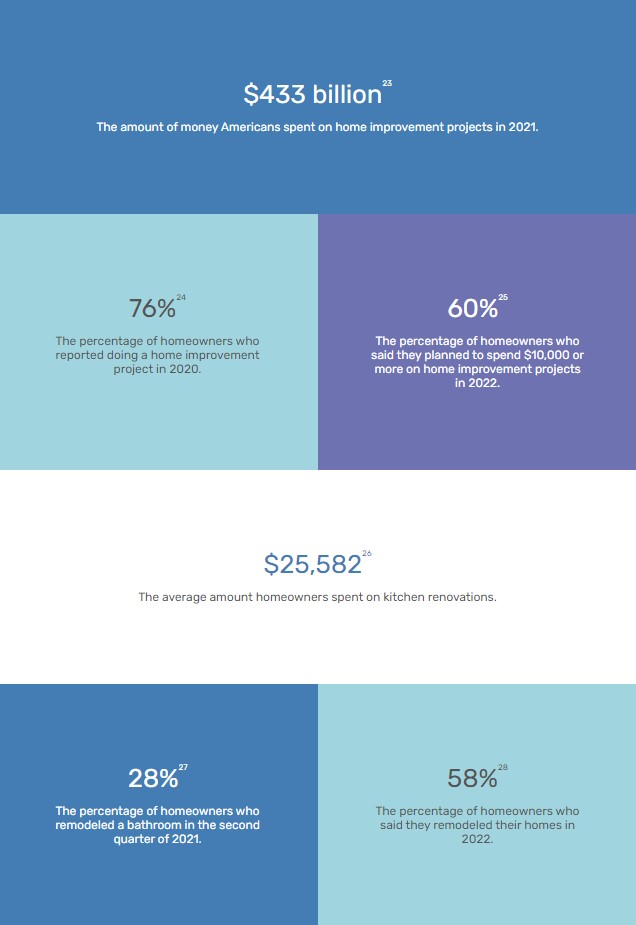U.S. Markets
Stocks extended their rally in the second quarter, boosted by cooling inflation, the prospect of a shift in monetary policy, and enthusiasm over artificial intelligence.
For the three months ending June 30, the Dow Jones Industrial Average added 3.41 percent while the Standard & Poor’s 500 Index picked up 8.30 percent. The Nasdaq Composite, which led in the first quarter, led again, gaining 12.81 percent. [1]
“Efficiency is concerned with doing things right. Effectiveness is doing the right things.”
Peter Drucker, writer, consultant, and professor who’s widely credited as being the man who invented management.
Inflation Breaks
The stock market’s climb over the course of the second quarter did not come without occasional bumps along the way, including a drawn-out political battle over raising the debt ceiling.
One important driver that helped overcome these headwinds was the continued progress in the fight against inflation. Year-over-year inflation broke decisively lower in the April and May reports. The June report will be released on July 12, and moderating inflation may allow the Fed to ease up on further rate hikes. [2]
Support from Corporate Reports
Another driver was corporate reports. With 99 percent of the companies comprising the S&P 500 reporting, 78 percent reported a positive earnings surprise, while 75 percent reported a revenue surprise. The earnings beat percentage was the best performance relative to Wall Street estimates since the fourth quarter of 2021. [3]
Spotlight on Artificial Intelligence
These past corporate earnings season also saw a dramatic development—a heightened focus on artificial intelligence (AI), with 110 companies mentioning AI on conference calls. This was a 41 percent increase from the prior quarter. [4]
The excitement over AI centers on its potential economic opportunities. One investment bank says AI may increase economic productivity by 1.5 percent annually for the next ten years. [5]
More Names Join Rally
As welcome as this AI enthusiasm may have been, it exacerbated concerns that stock market returns have been concentrated in a handful of very large cap stocks and just a couple of industry sectors.
Encouragingly, market breadth steadily improved during the quarter. Despite the undeniable leadership of just seven mega-cap stocks, an increasing number of stocks are seeing better price momentum. For example, as of June 14, 61.8 percent of S&P 500 stocks were trading above their 50-day moving average. [6]
Sector Scorecard for Q2
The strong quarter performance lifted nearly all sectors with gains in Communications Services (+13.89 percent), Consumer Discretionary (+15.36 percent), Financials (+5.19 percent), Health Care (+2.65 percent), Industrials (+6.58 percent), Materials (+3.98 percent), Real Estate (+2.91 percent), and Technology (+16.23 percent). Losses were sustained in Consumer Staples (-1.06 percent), Utilities (-3.87 percent), and Energy (-1.54 percent). [7]
 What Investors May Be Talking About in July
What Investors May Be Talking About in July
In July, companies will start to report their Q2 results, which will provide fresh insights into the economy’s health. Corporate results may go a long way in signaling to investors whether the first-half rally in stock prices was warranted or premature and deserving of some valuation adjustment.
Additionally, the two-day Fed meeting ends on July 26. Investors will learn whether the Fed plans to increase rates or hold steady. Much may depend on the update on consumer prices, set for release on July 12. [8,9]
At the June meeting, the Fed elected to pause on rate hikes, deciding to assess the economic impact of the cumulative interest rate increases that started last year. The Fed will also give its outlook for inflation in the second half.
World Markets
The MSCI-EAFE Index gained 1.87 percent in the second quarter as overseas markets were hobbled by persistently elevated inflation in multiple major markets and economic softness, exemplified by Germany entering a recession and a faltering China reopening. [10]
European markets were mixed in Q2, with gains in France (+1.06 percent), Italy (+4.12 percent), Spain (+3.90 percent), and Germany (+3.32 percent). The UK lagged, falling 1.31 percent. [11]
Pacific Rim markets were also mixed, with Hong Kong down 7.27 percent while Japan rose 18.36 percent. [12]
 Indicators
Indicators
Gross Domestic Product (GDP)
The economy’s total output in the first quarter was revised higher, from a 1.3-percent expansion to a 2.0-percent growth rate, casting doubt that the economy was headed to recession. [13]
Employment
Employers added 339,000 new jobs in May, which exceeded the 190,000 consensus forecast. The unemployment rate jumped to 3.7 percent despite no change in the labor force participation rate. Year-over-year wage growth cooled to 4.3 percent. [14]
Retail Sales
Retail sales increased 0.3 percent in May after rising 0.4 percent the month before. Consumer spending was higher across the board. [15]
Industrial Production
Following two consecutive months of increases, industrial production shrank 0.2 percent in May, a consequence of falling output in the mining and utilities sectors. Manufacturing was up a modest 0.1 percent for the month. [16]
Housing
Housing starts rose 21.7 percent in May as low inventory boosted buyers’ interest and home builders’ confidence. It was the largest percentage gain since October 2016. [17]
Sales of existing homes fell 0.2 percent, while year-over-year sales dropped 20.4 percent. [18]
New home sales gained 12.2 percent in May, rising for the third consecutive month. [19]
Consumer Price Index (CPI)
Consumer prices rose 0.1 percent in May and 4.0 percent from one year ago. This was the lowest annual rate in more than two years. Nevertheless, core inflation (excludes volatile food and energy prices) picked up 0.4 percent in May, while year-over-year core prices increased 5.3 percent, reflecting continued inflationary pressures. [20]
Durable Goods Orders
Orders for goods designed to last three or more years increased 1.7 percent in May, powered by increased sales of passenger planes and automobiles. It was the third straight month that durable goods orders have climbed. [21]
The Fed
After raising interest rates unanimously by 0.25 percent following the March and May meetings of the Federal Open Market Committee (FOMC), the Fed elected to keep rates unchanged in June, pausing to assess the economic impact of the cumulative rate hikes to date.
Language in the rate announcement and comments by Fed Chair Powell indicate that, despite the pause, two more rate hikes are likely before the end of the year. [22]
By the Numbers: Home Improvement

Lighthouse Financial, LLC may be reached at www.lighthousefinancialllc.com, 303-444-1818 or wisdom@lighthousefinancialllc.com.
Investment and Advisory services are provided by Petra Financial Advisors, Inc., headquartered at 2 N. Nevada Ave. Suite 1300, Colorado Springs, CO 80903.
The content is developed from sources believed to be providing accurate information. The information in this material is not intended as tax or legal advice. Please consult legal or tax professionals for specific information regarding your individual situation. This material was developed and produced by FMG Suite to provide information on a topic that may be of interest. FMG Suite, LLC, is not affiliated with the named representative, broker-dealer, or state- or SEC-registered investment advisory firm. The opinions expressed and material provided are for general information and should not be considered a solicitation for the purchase or sale of any security.
Investing involves risks, and investment decisions should be based on your own goals, time horizon and tolerance for risk. The return and principal value of investments will fluctuate as market conditions change. When sold, investments may be worth more or less than their original cost.
Any companies mentioned are for illustrative purposes only. It should not be considered a solicitation for the purchase or sale of the securities. Any investment should be consistent with your objectives, timeframe, and risk tolerance.
The forecasts or forward-looking statements are based on assumptions, subject to revision without notice, and may not materialize.
The market indexes discussed are unmanaged and generally considered representative of their respective markets. Individuals cannot directly invest in unmanaged indexes. Past performance does not guarantee future results.
The Dow Jones Industrial Average is an unmanaged index that is generally considered representative of large-capitalization companies on the U.S. stock market. The S&P 500 Composite Index is an unmanaged group of securities considered to be representative of the stock market in general. The Nasdaq Composite is an index of the common stocks and similar securities listed on the Nasdaq stock market and considered a broad indicator of the performance of stocks of technology and growth companies. The Russell 1000 Index is an index that measures the performance of the highest-ranking 1,000 stocks in the Russell 3000 Index, which is comprised of 3,000 of the largest U.S. stocks. The MSCI EAFE Index was created by Morgan Stanley Capital International (MSCI) and serves as a benchmark for the performance in major international equity markets, as represented by 21 major MSCI indexes from Europe, Australia, and Southeast Asia. Index performance is not indicative of the past performance of a particular investment. Past performance does not guarantee future results. Individuals cannot invest directly in an index. The return and principal value of stock prices will fluctuate as market conditions change. And shares, when sold, may be worth more or less than their original cost.
International investments carry additional risks, which include differences in financial reporting standards, currency exchange rates, political risks unique to a specific country, foreign taxes and regulations, and the potential for illiquid markets. These factors may result in greater share price volatility.
The Hang Seng Index is a benchmark index for the blue-chip stocks traded on the Hong Kong Stock Exchange. The KOSPI is an index of all stocks traded on the Korean Stock Exchange. The Nikkei 225 is a stock market index for the Tokyo Stock Exchange. The SENSEX is a stock market index of 30 companies listed on the Bombay Stock Exchange. The Jakarta Composite Index is an index of all stocks that are traded on the Indonesia Stock Exchange. The Bovespa Index tracks 50 stocks traded on the Sao Paulo Stock, Mercantile, & Futures Exchange. The IPC Index measures the companies listed on the Mexican Stock Exchange. The MERVAL tracks the performance of large companies based in Argentina. The ASX 200 Index is an index of stocks listed on the Australian Securities Exchange. The DAX is a market index consisting of the 30 German companies trading on the Frankfurt Stock Exchange. The CAC 40 is a benchmark for the 40 most significant companies on the French Stock Market Exchange. The Dow Jones Russia Index measures the performance of leading Russian Global Depositary Receipts (GDRs) that trade on the London Stock Exchange. The FTSE 100 Index is an index of the 100 companies with the highest market capitalization listed on the London Stock Exchange.
Please consult your financial professional for additional information.
Copyright 2023 FMG Suite.
- WSJ.com, June 30, 2023
- TradingEconomics.com, June 30, 2023
- Advantage.Factset.com, June 1, 2023
- Advantage.Factset.com, May 26, 2023
- CNBC.com, May 17, 2023
- ETFDB.com, June 21, 2023
- SectorSPDR.com, June 30, 2023
- FederalReserve.gov, 2023
- BureauLaborStatistics.gov, 2023
- MSCI.com, June 30, 2023
- MSCI.com, June 30, 2023
- MSCI.com, June 30, 2023
- CNBC.com, June 29, 2023
- CNBC.com, June 2, 2023
- WSJ.com, June 16, 2023
- Morningstar.com, June 15, 2023
- Reuters.com, June 20, 2023
- CNBC.com, June 22, 2023
- Morningstar.com, June 27, 2023
- CNBC.com, June 13, 2023
- MarketWatch.com, June 27, 2023
- CNBC.com, June 14, 2023
- JCHS.Harvard.edu, 2023
- Zippia.com, March 12, 2023
- PRNewswire.com, February 4, 2022
- Wickedlocal.com, November 24, 2021 (2021 study)
- Zippia.com, March 12, 2023
- Kitchenbathdesign.com, March 27, 2023
